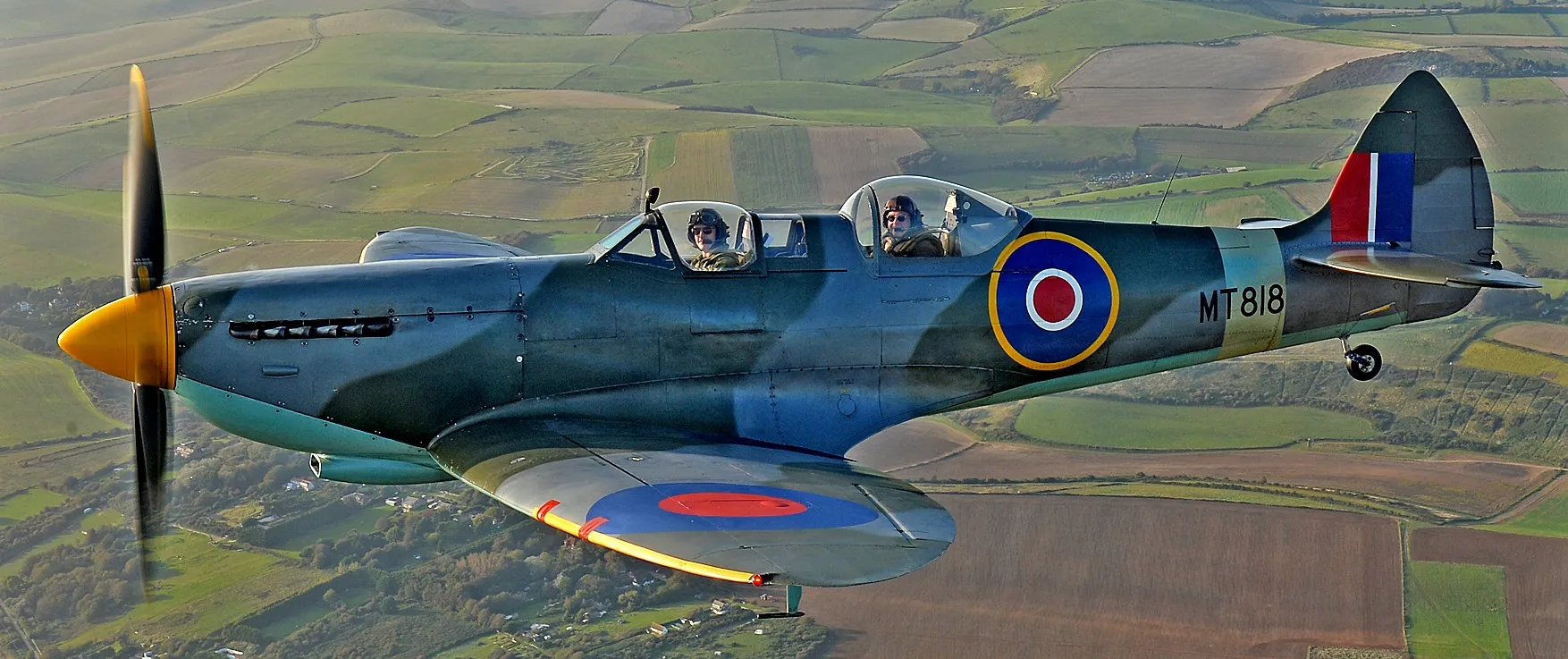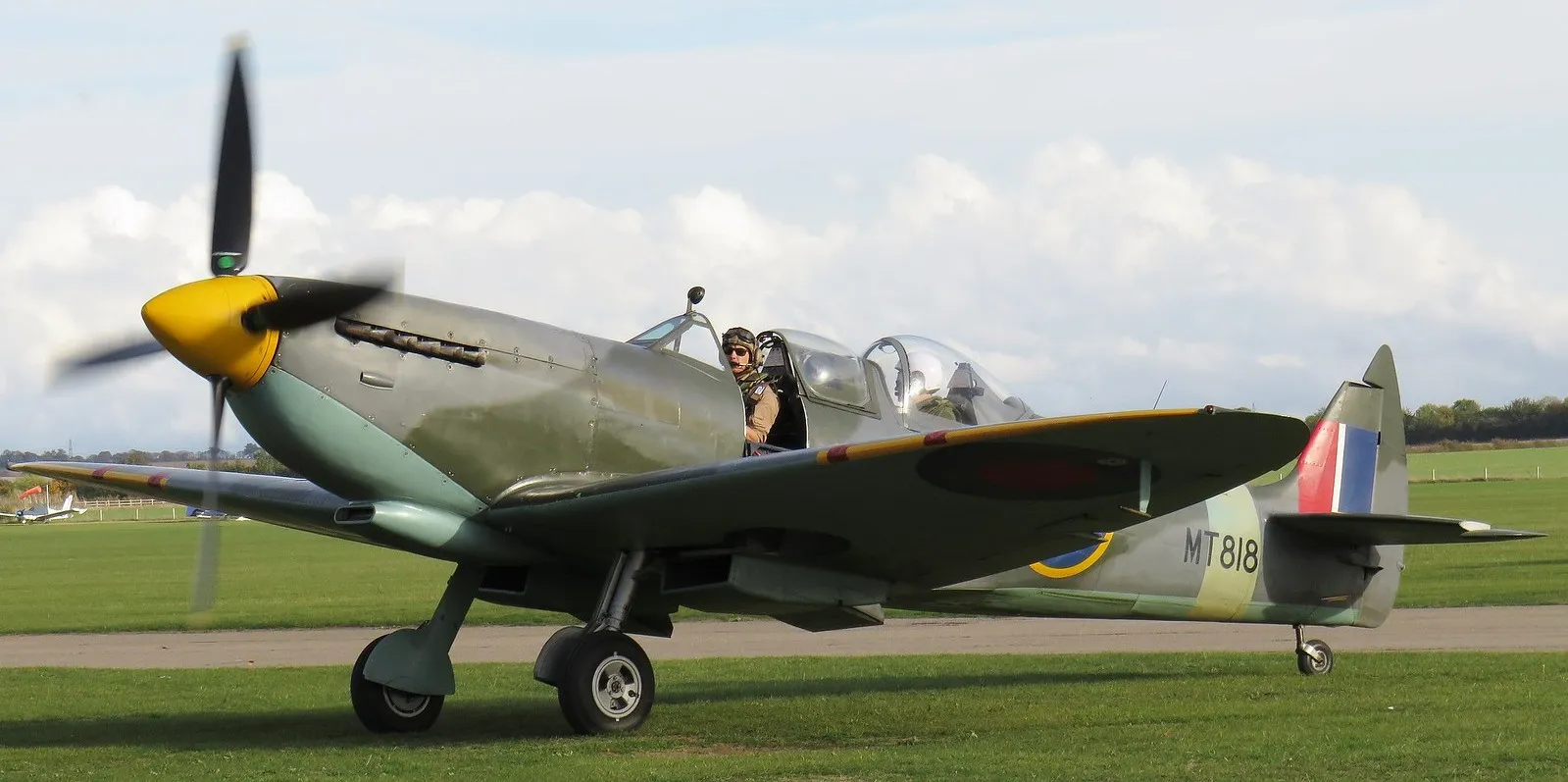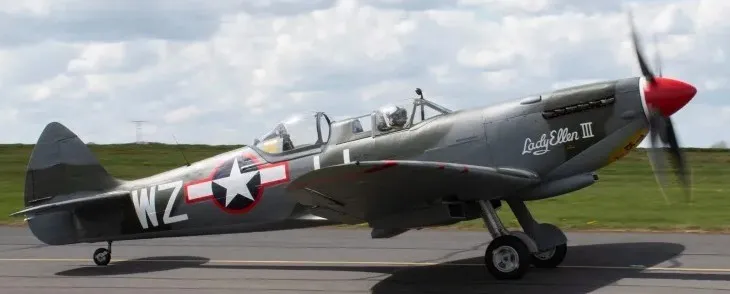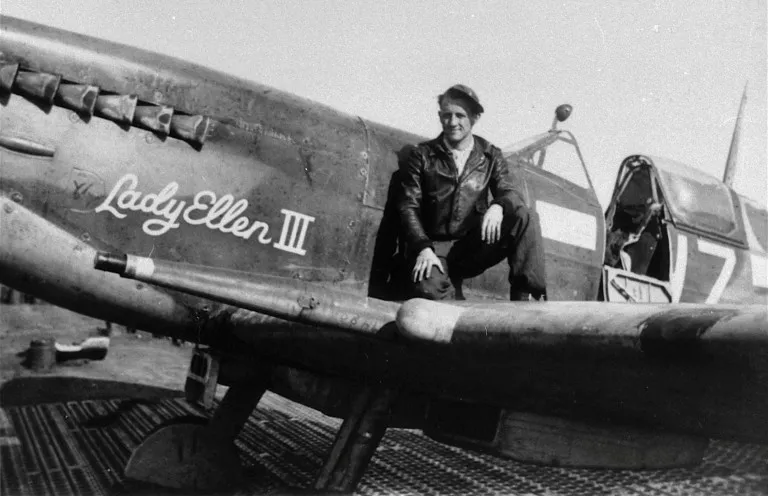Warplanes of the UK: Supermarine Spitfire Mk. VII and Mk. VIII
Supermarine Spitfire Mk. VII

(NACA Photo)
Supermarine Spitfire HF Mk. VII (Serial No. EN474) at Langley, 1943. This Spitfire was tested by the USAAF and is now housed at the Smithsonian National Air and Space Museum, the only surviving example of a Mk VII. Note the "pointed", extended wingtips and the cabin pressurisation air intake under the exhausts. The shape of the ellipse was altered by the extended "pointed" wing tips used by the high-altitude Mk. VIs, VIIs, and early Mk VIIIs.
All Mk VII and Mk VIII Spitfires had the following changes: The internal structure was strengthened and revised. On the wings the ailerons were reduced in span by 8.5 inches (220 mm) outboard of the outer hinges. There had been some instances of earlier models breaking up in the air in steep high speed dives, it was thought, because of aileron flutter.The main fuselage fuel tanks were increased in capacity; 47 gal (213.7 L) for the upper tank and 49 gal (222.7 L) for the lower. In combination with the wing tanks this gave a total internal capacity of 122 gal (554.6 L), a near 50% increase over the 85 gal (386.4 L) carried by earlier Spitfire marks. In addition a 13 gal (64 L) fuel tank was fitted in each wing leading edge between the wingroot and the inner gun-bay.
The main undercarriage legs, for the first time in the Spitfire's life, were fitted with forward-facing torque links. In addition, the leg doors were slightly concave, allowing the undercarriage to sit lower in the wheel wells when retracted: this meant the upper wing skinning was free of the small bulge which had hitherto been necessary to clear the wheels. The wheels themselves were a new strengthened Dunlop AH10019 "four spoke" pattern, replacing the "five spoke" pattern used since the first Mk Is. This revised undercarriage was also fitted on some mid to late Mk IXs and all Mk XVIs. A retractable tailwheel (Dunlop 2184) was fitted, covered by small doors when in flight. This also applied to the PR Mk Xs and most PR Mk XIs. (Wikipedia)
Like the Mk VI, the Mk VII was a high altitude pressurised variant, this time powered by the Merlin 64 (F. Mk. VII) or 71 (H.F. Mk. VII) series engine with two-stage, two-speed superchargers. The cockpit was pressurised in a similar way to that of the Mk VI, although the details were slightly different. Other changes to the airframe are noted above. The Mk VII used a Marshall manufactured compressor for pressurising the cockpit; this was mounted on the right of the engine and drew its air through a long intake under the starboard exhaust stubs. An automatic valve allowed a maximum pressure differential of +2 lb./sq.in. This was built up during the climb and was maintained at heights of 28,000 ft and above.
Extended, "pointed" wingtips were fitted to the Type C wings, increasing the wingspan to 40 ft 2 in (12.2 m). Because the threat from high altitude bombers never materialised many Mk VIIs later reverted to the normal, rounded wingtip.While early Mk VIIs were fitted with a detachable canopy, secured by four pilot-operated catches, later Mk VIIs were fitted with a "Lobelle"-type hood which opened by sliding backwards, as on non-pressurised versions of the Spitfire. This was a big improvement on the clampdown cockpit of the Mk VI. The canopy was double-glazed and used rubber tubing to create a proper pressure seal against the fuselage. The canopy rails were bulkier than the standard Spitfire type.
In total, 140 Mk VIIs were built by Supermarine. Most of them were powered by the Merlin 64 (F. Mk. VII) or Merlin 71 (H.F Mk. VII), the latter fitted with a Bendix-Stromberg "anti-g" carburettor. The HF Mk had superb high-altitude performance, with a service ceiling of 45,100 feet (13,700 m); French ace Pierre Clostermann recalls in his book, The Big Show, the successful interception of a long-range reconnaissance Messerschmitt Bf 109G-6/R3 by a Mk VII 'Strato Spitfire' of 602 Squadron at 40,000 feet (12,000 m) over the British Home Fleet's base at Scapa Flow in early 1944. (Wikipedia)

(DND Photo, PL 8515)
Supermarine Spitfire. F Mk. VIII (Serial No. JF336), coded AN-O, No. 417 Squadron, RCAF. Harmonization of the guns. The aircraft has to be jacked-up level to ensure the guns are lined-up correctly to test fire.
Supermarine Spitfire LF Mk. VIII (Serial No. JF872), Reg. No. G-RAAF, stored in Lancashire.
Supermarine Spitfire LF Mk. VIIIc (Serial No. JG668), delivered to the RAAF as (Serial No. A58-441) and was struck off charge in 1948. Registered as G-CFGA to The Pembrokeshire Spitfire Aeroplane Company, Welsh Spitfire Museum, Haverfordwest.

(Library and Archives Canada Photo, MIKAN No. 4532542)
Supermarine Spitfire LF Mk. VIIIc (Serial No. JG567), "Mary Ann", No. 67 Squadron, RAF. Pilots are sitting in a jeep in front of the Commanding Officer's Spitfire at Akyab, Burma, 9 Jan 1945. This was a day after a section led by the CO shot down five Japanese Nakajima Ki 43 Oscars from a force which attacked the port following its reoccupation. Four of the five Nakajima Ki-43 kills from the 64th Sentai, IJAAF, were confirmed by post-war examination of Japanese records.
At the wheel is the Commanding Officer, Squadron Leader R.W.R. "Bob" Day from Victoria, British Columbia, who shot down two of the Ki 43s, and sitting next to him is Flight Lieutenant C.M. Simpson, who claimed another two. The other pilots are, (left to right), Warrant Officer G.W. Milsom, Flight Sergeant E.R. Owen and Pilot Officer L. Brett. JG567 was struck off charge in May 1945. (PLC0169)

(Mike Freer - Touchdown-aviation Photo, 1974)

(Richard Foord Photo)

(Professor M Photo)

(Fly a Spitfire Photo)
Supermarine Spitfire TR Mk. VIII (Serial No. MT818), c/n 729058), coded G-M, (Spitfire T.8), previously Reg. No. N58JE, now UK Reg. No. G-AIDN, G2 Trust, Wycombe Air Park. Biggin Hill Heritage Hangar, Biggin Hill Airport, Westerham, Kent. Airworthy in the UK. Two-seat trainer built in 1944, restored to airworthy condition by Personal Plane Services, Booker, Buckinghamshire, last seen flying on 30 June 2024. (Wikipedia) This aircraft has been repainted to represent a USAAF Mk. IXc (Serial No. MH894), coded WZ-JJ, "Lady Ellen III", as flown by Lt John Fawcett of the 31st Fighter Group's 309th Fighter Squadron between Nov 1943 and March 1944, while assigned to the 12th Air Force in Italy. MT818 is unique as the only surviving Spitfire prototype of any mark. This was the first and only ‘Spitfire High Speed Trainer Prototype’ trainer created by Vickers-Armstrongs.

(USAAF Photo)
Lt John Fawcett with his Supermarine Spitfire Mk. IXc (Serial No. MH894), coded WZ-JJ, "Lady Ellen III".





